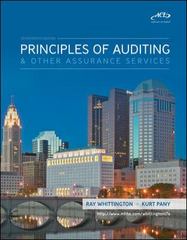Answered step by step
Verified Expert Solution
Question
1 Approved Answer
Case Study: Audit Planning and Risk Assessment Background: XYZ Corporation, a multinational manufacturing company, is preparing for its annual external audit. The company's management team
Case Study: Audit Planning and Risk Assessment
Background:
XYZ Corporation, a multinational manufacturing company, is preparing for its annual external audit. The company's management team recognizes the importance of thorough audit planning and risk assessment to ensure the audit process is conducted effectively and efficiently.
Audit Planning:
The audit planning process involves several key steps to prepare for the upcoming audit:
Understanding the Business: The audit team conducts meetings with management to gain a comprehensive understanding of the company's operations, industry, regulatory environment, and key business risks.
Assessing Materiality: The auditors determine materiality thresholds based on quantitative factors such as total assets, revenues, or net income, as well as qualitative considerations such as regulatory requirements and user expectations.
Identifying Significant Accounts and Transactions: The audit team identifies significant accounts and transactions that are material to the financial statements and require detailed testing.
Developing the Audit Plan: Based on the understanding of the business and assessment of materiality, the audit team develops a detailed audit plan outlining the scope, objectives, timing, and resources required for the audit engagement.
Risk Assessment:
Risk assessment is a crucial component of audit planning and involves identifying and evaluating risks that may impact the financial statements. The audit team focuses on both inherent and control risks:
Inherent Risks: These are risks related to the nature of the company's business, industry, and economic environment. Examples include technological changes, market competition, and regulatory changes.
Control Risks: These are risks associated with the effectiveness of internal controls in preventing or detecting material misstatements in the financial statements. Weaknesses in internal controls increase the likelihood of errors or fraud going undetected.
Case Study Objective Type Question:
Based on the case study, which type of risk is associated with weaknesses in internal controls?
A Inherent Risks
B Control Risks
C Detection Risks
D Financial Risks

Step by Step Solution
There are 3 Steps involved in it
Step: 1

Get Instant Access to Expert-Tailored Solutions
See step-by-step solutions with expert insights and AI powered tools for academic success
Step: 2

Step: 3

Ace Your Homework with AI
Get the answers you need in no time with our AI-driven, step-by-step assistance
Get Started


